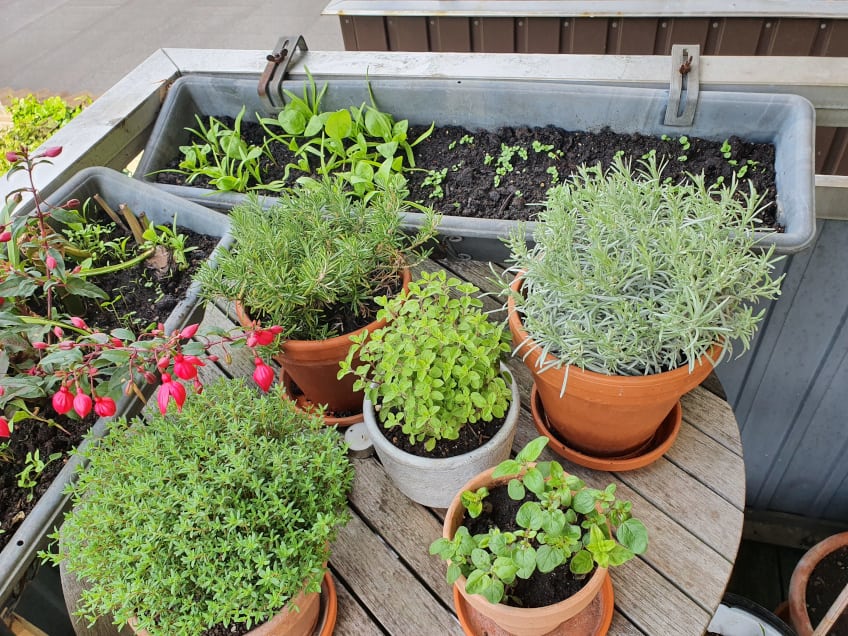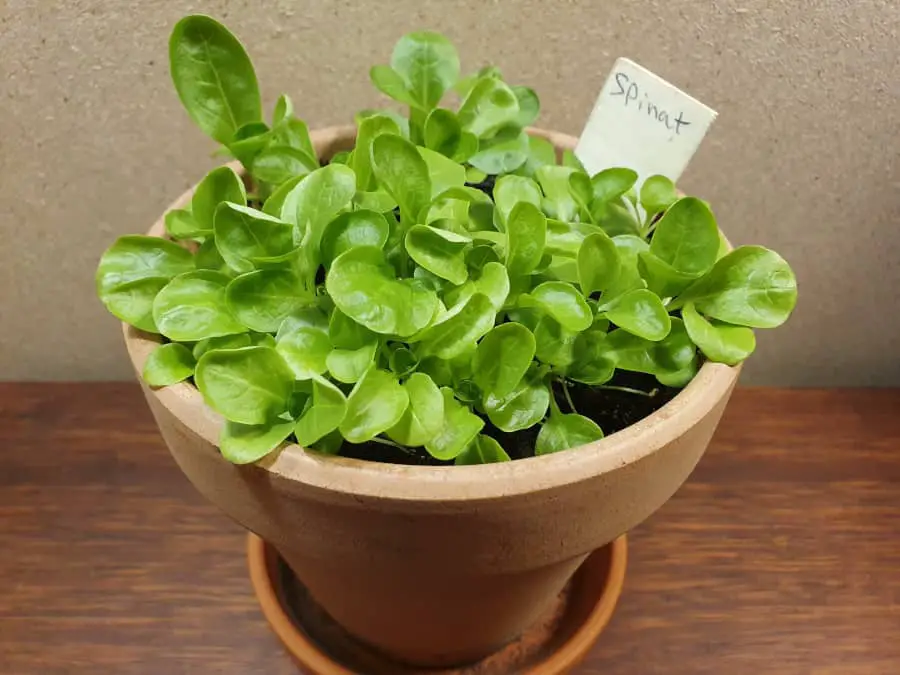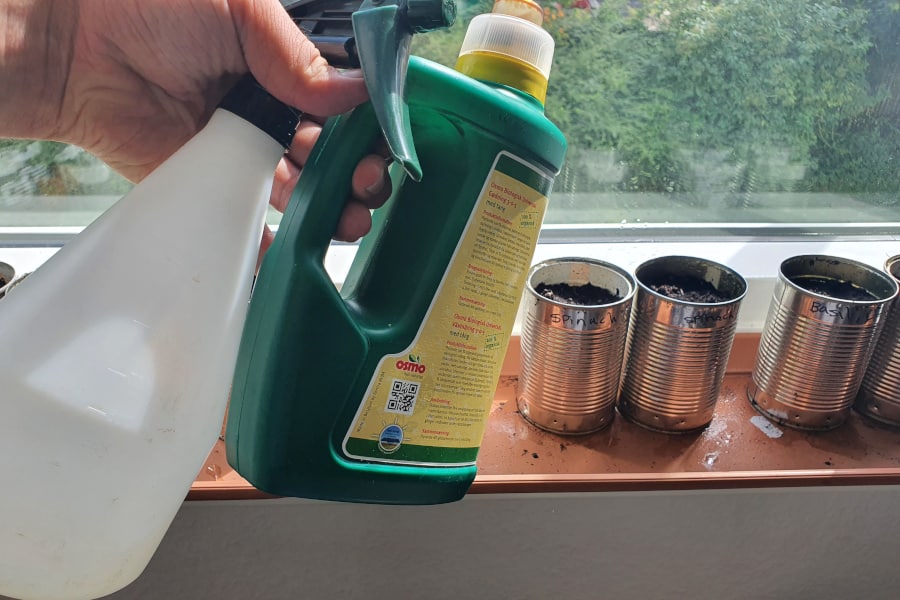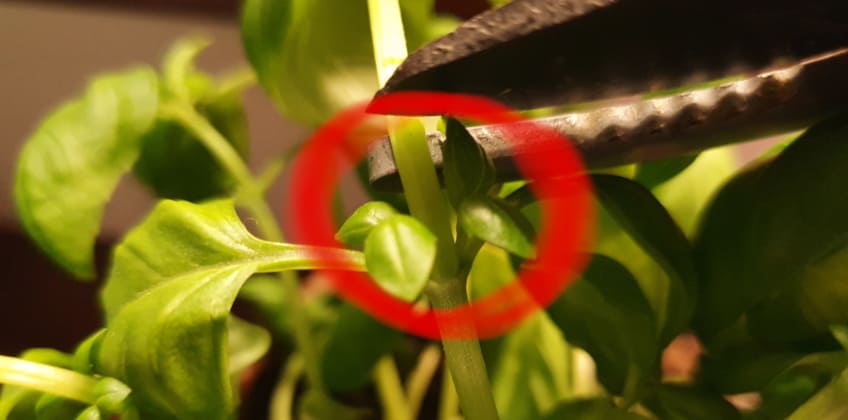It is a common misconception that gardening requires a lot of space. In fact, you can grow a surprisingly large amount of food even if all you have is a balcony, 100 square feet of unused space outside, or even just an empty window sill.
I know this for a fact because I used to live in an apartment with a small balcony as the only outdoor space and I managed to grow far more food on that balcony than I ever imagined was possible. The photo below shows one of the corners of my tiny balcony garden.
I learned that the key to growing a lot of food in a small space is to optimize everything. Of course, I tested a lot of things for myself to see how I could grow as much as possible in the space I had, but I also learned a lot of good tips by talking to other gardeners and experts. Now I want to share those tips with you.
I have written this article to share 16 easy but incredibly effective tricks you can use to grow a ton of food in whatever small space you have.

1. Use a Gardening Method That Fits You and Your Space
The first tip I want to give you is to figure out which gardening method fits you and your space best.
If you have a small space outside or on a balcony, you can consider trying square-foot gardening, vertical gardening, or container gardening. If you have some unused space next to a window, you could try growing microgreens.
If you want some more inspiration, you can read the article on this link, where I write about five gardening methods that work in small spaces and when each method is best.
2. Choose Plants That Produce a Lot Compared to Their Size
One of the most important (if not the most important) things you can do to grow as much food as possible in a small space is to choose plants that produce a lot compared to their size.
This is one of the reasons I love to grow herbs. They don’t take up too much space and can be incredibly productive. You don’t have to limit yourself to growing herbs, though. There are also a lot of vegetables, berries, and even fruit trees you can grow in a small space.
If you want some more ideas, head over to this article, where I come with 43 examples of plants you can grow in small spaces.
3. Choose Small and Compact Varieties
Plants come in many varieties, some of which are large and some of which are small. If you only have a small space to grow your plants, it is important that you don’t pick just any variety since you can end up with some plants that take up much more space than you intended.
When choosing plants for your small space, go for small, compact varieties. If you buy seeds, it will usually say how large the plants get somewhere on the packet. For fruit trees, look into dwarf varieties.
Some of my favorite small plants and varieties are Greek basil, Tiny Tim tomatoes, and Bush Champion cucumbers.
4. Choose Fast-Growing Plants for Multiple Harvests
If you choose fast-growing plants, you can easily grow multiple rounds and get multiple harvests within a single growing season.

Some of my fast-growing favorites are lettuce, spinach, and radishes. Depending on the variety and the growing conditions, they can be fully grown and ready to harvest within a month.
I sometimes like to sow spinach and lettuce a bit more densely than what the seed packet says if all I have is one pot or a small spot. That way the plants end up looking like mine in the photo above.
5. Use Interplanting to Grow More Plants in the Same Spot
Interplanting essentially means growing multiple plants in the same spot. It is an excellent way to maximize the yield from each spot without needing more space.
I got this tip from an employee at one of the garden centers I like to go to. She recommended growing lettuce and spinach underneath larger plants such as tomatoes and cucumbers. I personally love to grow basil underneath my tomatoes.
In the article on this link, I talk about where to plant what in the garden, and at the bottom of the article, you can find a table where I have listed some good companion plants (plants that grow well together) for some of the most common garden plants.
6. Use Succession Planting for Multiple Harvests in Each Spot
Succession planting means replacing plants with other plants once they are done growing and producing. If you keep replacing plants as soon as they are done, you can end up getting a lot of food from each spot.
Just because a plant is done growing and producing, it doesn’t mean that the spot it grew in is done. Pull up your plants once they are done and plant something else immediately after. That way you can get to harvest multiple times from each spot within the same season.
At one point, I talked to a gardening expert about succession planting and he gave me a simple but effective tip to optimize it even further. The tip was to sow the next round of plants a few weeks before it is time to put them out. That way they are already relatively large when you replace something else with them.
I do this by simply planting the seeds in small seed starter pots next to my window where they stay until I plant them in the garden. Once they are ready, I transplant them into the garden. You can read a bit more about that here.
7. Utilize Vertical Space to Grow More in One Spot
Vertical gardening is a wonderful way to grow large plants or several smaller plants in a very small space.
You can grow climbing plants such as pole beans and certain tomato and cucumber varieties on a trellis or a pole to make them grow upwards instead of spread horizontally. You can also get some pots that can be stacked to essentially allow you to grow a lot of small plants on top of each other.
On the small balcony, I used to have which I used as a tiny garden, I would put pots with various plants on the floor and put some hanging pots above them. That way I grew two plants on top of each other without using more horizontal space.
8. Make Good Use of the Spots That Don’t Get Much Sunlight

If you have a small space and you want to grow as much food as possible, chances are you will pack your plants relatively densely. That is usually fine, but you have to keep in mind that some of the plants are inevitably going to cast shade on other plants.
Most herbs and vegetables need plenty of sunlight, so they won’t grow well in the shade of other plants. That said, there are plenty of plants you can grow in the shade of other plants. A couple of good examples I like are lettuce, chard, radishes, and kale.
You should also keep in mind that planting too densely usually leads to problems, so while planting densely can be good, planting too densely is bad. You can read about what happens if plants don’t have enough space on this link.
The photo above is taken inside my greenhouse. There is a large grape vine growing at the back and up near the top on the left side, but notice how I grow all kinds of plants underneath it.
9. Use High-Quality Soil to Get the Most Productive Plants
It is, of course, important to use good soil no matter what, but it is especially important if you have a small space and want to grow as much food as possible in it. Using better soil is one of the easiest ways to make plants produce as much as possible.
This is because the soil contains all the nutrients for the plants as well as determines how well water drains. If the soil you use has poor drainage, the water stays around the roots for a long time. This can cause the roots to rot, which will kill the plant.
Most of the common vegetables and herbs grow best in nutrient-rich soil with high sand content. The nutrients typically come from organic matter and the sand helps improve drainage and aeration.
10. Use an Organic All-Round Vegetable Fertilizer
One of the keys to growing a lot of food in a small space is to have productive plants. Using a good fertilizer can help your plants become more productive than they would otherwise.

If you use high-quality soil with lots of organic matter and good drainage, you are already doing great. Something you can sometimes do to increase production from your plants even further is to use fertilizer. I use (and recommend) a simple, organic, all-round vegetable fertilizer.
If you want to get more technical, you can look into what specific nutrients the plants you grow need and get a fertilizer made specifically for that. That can be great, but in my experience, a good, organic, all-round fertilizer is usually sufficient and is a simple way to make your plants grow and produce a bit more.
11. Don’t Grow the Same Plant in the Same Spot Over and Over
Plants use specific nutrients, so if you grow the same plant in the same spot over and over again, the soil will end up becoming depleted of those nutrients and the plants that used to grow well there don’t anymore.
The easiest thing you can do to prevent this from happening is just to rotate between plants and spots. Once a plant is done producing, remove it and plant something else.
Sure, this is important no matter how much space you have, but it is especially important to keep in mind in small spaces since you don’t have as much space to rotate between plants.
12. Harvest Early, Often, and Correctly
How and when you harvest your plants greatly affects how much they will grow and produce in total. If you want to get as much as possible out of a small garden, you should learn how to harvest correctly to maximize how much each plant produces.
For the most common vegetables such as tomatoes, cucumbers, and zucchini, the best thing you can do is to harvest as soon as the fruit is ready. That way, the plant starts focusing on producing more fruit. This is because the plant’s goal is to produce seeds and if you pick the fruit before the seeds are fully mature, the plant will produce more fruit in order to finish producing seeds. So harvest early and harvest often!
For most herbs including basil, mint, rosemary, oregano, thyme, and more, you shouldn’t harvest by just picking the leaves you need. Instead, cut or pinch the stems that have the leaves you need just above a leaf node, and then just remove the leaves from the stem you cut. Here is a photo I took of one of my basil plants to show you precisely where to cut. The idea is the same for the other herbs I mentioned.

By cutting the stem, the part that is left on the plant will split and grow into two new stems, thereby doubling the production. This way, you can get some super bushy and productive herbs that don’t take up much space. Just remember that while this trick works for most herbs, it doesn’t work for all.
13. Grow Plants During All the Seasons
Most garden plants need plenty of sunlight and high temperatures to thrive, but there are also plenty of plants that can grow and produce during the colder months.
I like to grow radishes, carrots, kale, and cabbage when it is too cold for most other plants.
Figure out which plants you like that can grow in the colder months of the year. Utilizing your growing space at all times is one of the most important things you can do to maximize the overall yield.
14. Grow Plants That You Actually Want to Eat or Use
It might seem a bit obvious, but I know from myself that it can be very easy to get excited and grow whatever you can just because it grows well. I used to do that a lot, but now I have learned to focus more on the things I actually enjoy eating.
My advice if you only have a small space to grow food is to prioritize plants you actually want to use. Don’t grow something just because it fits well in your space. Lettuce and spinach are two of my go-to plants if I don’t know what else to plant in a spot. They fit more or less anywhere.
That said, there should always be room for at least a little bit of experimentation. At least in my opinion, so don’t hesitate to try some new plants once in a while as long as you also focus on what you actually want to eat.
15. Grow Climbing Plants on Walls
As I wrote at the beginning of this article, the reason why I have learned so much about how to grow as much food as possible in small spaces is that all the “garden” space I used to have (a while ago) was a balcony.
I talked to an expert from a gardening company multiple times back then and one of the things he advised me to do with my balcony was to grow climbing plants on the walls. He recommended grapes specifically. It is a great way to produce more food without using much more than a few inches of horizontal space.
If you have a wall or similar in your space, you can also try to grow climbing plants like this. All you need is to get a trellis and attach it to the wall and then plant your climbers underneath it. They will most likely figure out how to climb upwards on their own, but you might have to assist them sometimes.
16. Grow Perennial Plants
Perennial plants are plants that can live for multiple years. Growing these is a great way to utilize a small space since they typically don’t require as much maintenance as annual plants and can produce a lot of fruit or leaves (depending on the plant).
I really love to grow perennial herbs if I have a small space outside I don’t use for anything. Mint, thyme, rosemary, and oregano are some of my favorite perennial herbs.
The reason why I recommend them for a small space is that they often become ready for harvest before most of the annuals and keep producing for longer too. This gives them a high overall yield. Rosemary, for example, can even be harvested all year round in some cases.
